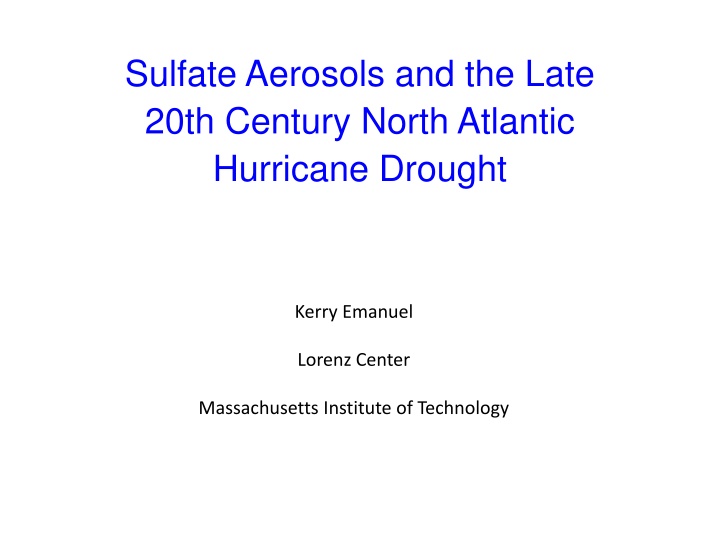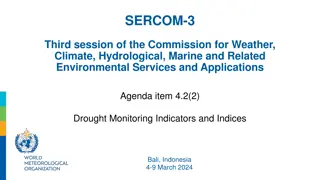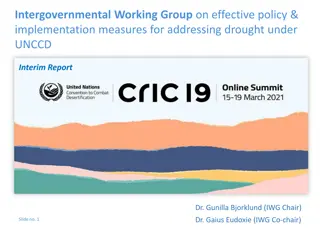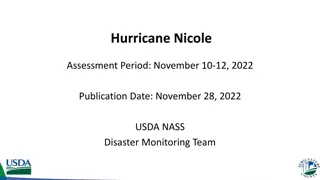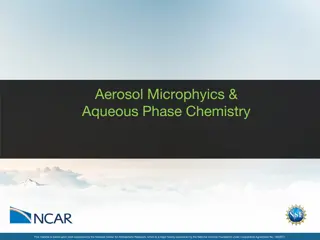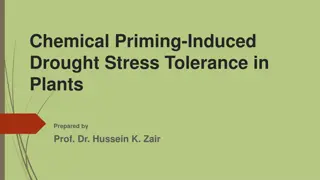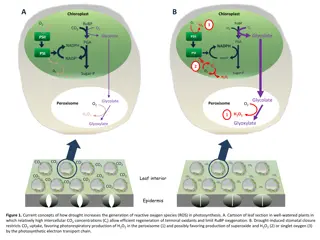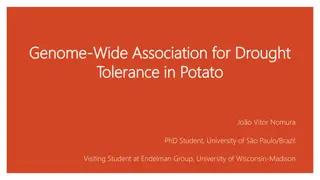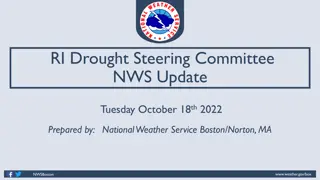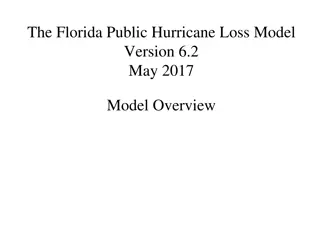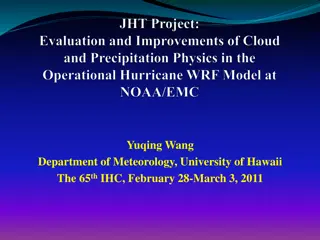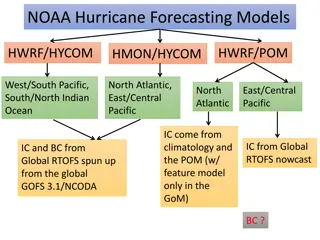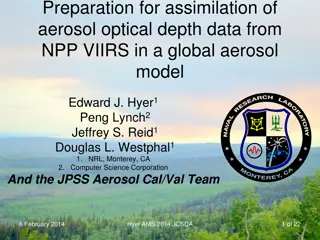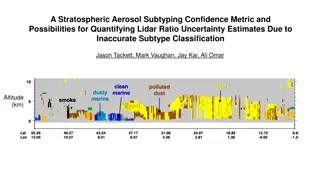North Atlantic Hurricane Drought and Aerosol Impact
This study explores the influence of sulfate aerosols on the late 20th-century North Atlantic Hurricane drought, focusing on the interaction of European sulfate aerosols and African dust. It investigates the radiative forcing effects and variability in hurricane activity, proposing hypotheses related to radiative forcing variations and natural oscillatory modes. The analysis considers factors like ocean heat flux, surface wind speed, CO2, and solar forcing, with regression analysis to understand storm variability.
Download Presentation

Please find below an Image/Link to download the presentation.
The content on the website is provided AS IS for your information and personal use only. It may not be sold, licensed, or shared on other websites without obtaining consent from the author.If you encounter any issues during the download, it is possible that the publisher has removed the file from their server.
You are allowed to download the files provided on this website for personal or commercial use, subject to the condition that they are used lawfully. All files are the property of their respective owners.
The content on the website is provided AS IS for your information and personal use only. It may not be sold, licensed, or shared on other websites without obtaining consent from the author.
E N D
Presentation Transcript
Sulfate Aerosols and the Late 20th Century North Atlantic Hurricane Drought Kerry Emanuel Lorenz Center Massachusetts Institute of Technology
August-October MDR SST and Storm Lifetime Maximum Power Dissipation
Sulfate Aerosols and North Atlantic Hurricanes During the late 20th Century, global aerosol radiative forcing is thought to be of the same order as CO2 radiative forcing Per unit sea surface temperature change, shortwave forcing is roughly twice as effective as longwave forcing in changing potential intensity Much of the interannual variability of aerosol forcing over the tropical North Atlantic in summer is thought to be owing to the interaction of sulfate aerosols of European origin with African dust (Li-Jones and Prospero, 1998)
Variation of Potential Intensity with Ocean Heat Flux, Surface Wind Speed, CO2, and Solar Forcing Emanuel, K., and A. Sobel, 2013: Response of tropical sea surface temperature, precipitation, and tropical cyclone-related variables to changes in global and local forcing. J. Adv. Model. Earth Sys., 5, doi:10.1002/jame.20032
Hypothesis: Multi-decadal variability of North Atlantic hurricane activity in the late 20th Century is owing to variations in shortwave and longwave radiative forcing Residual quasi-decadal hurricane variability is owing to a natural oscillatory mode of the North Atlantic, nominally equivalent to the Atlantic Multi-Decadal Oscillation (AMO)
Test: Separate North Atlantic Storm Maximum Power Dissipation into two parts: a) Long-period variability (10-year running average) and b) quasi-decadal variability (residual) Use multiple linear regression to regress long-period signal onto 20-year lagged log(CO2) and European sulfate emissions Correlate residual (quasi-decadal) signal in storm maximum power dissipation with North Atlantic potential intensity from NCEP reanalysis
Linearly regress European sulfates and log (CO2) onto low- pass-filtered storm maximum power dissipation
Map of r2 between Storm Max PDI and NCEP PI 60oN 0.6 48oN 0.5 36oN 0.4 24oN 0.3 12oN 0.2 0o 0.1 100oW 20oW 80oW 40oW 60oW
Multi-decadal Variability in 25 CMIP5 Climate Models Spectral peaks from 5 to 20 years From Ting et al, J. Climate, 2015. Data courtesy Mingfang Ting.
CMIP5 multi-decadal signal regressed onto potential intensity From Ting et al, J. Climate, 2015. Data courtesy Mingfang Ting.
Results from downscaling tropical cyclones from HADGEM2- ES, 1950-2005, 100 North Atlantic events per year
Summary A pronounced hurricane drought affected the North Atlantic from the 1960s through the early 1990s Hurricane power dissipation during this period was strongly inversely correlated with European sulfur emissions Spatial pattern of potential intensity projected onto hurricane power dissipation consistent with strong radiative forcing over the main development region Spatial pattern of residual potential intensity changes, with multi-decadal signal removed, consistent with CMIP5 signatures of Atlantic quasi-decadal natural variability Of 7 CMIP5 models downscaled, only the HADGEM model captures the Atlantic hurricane drought
